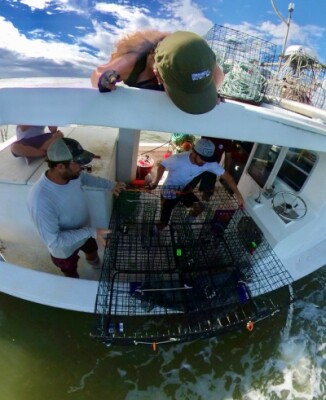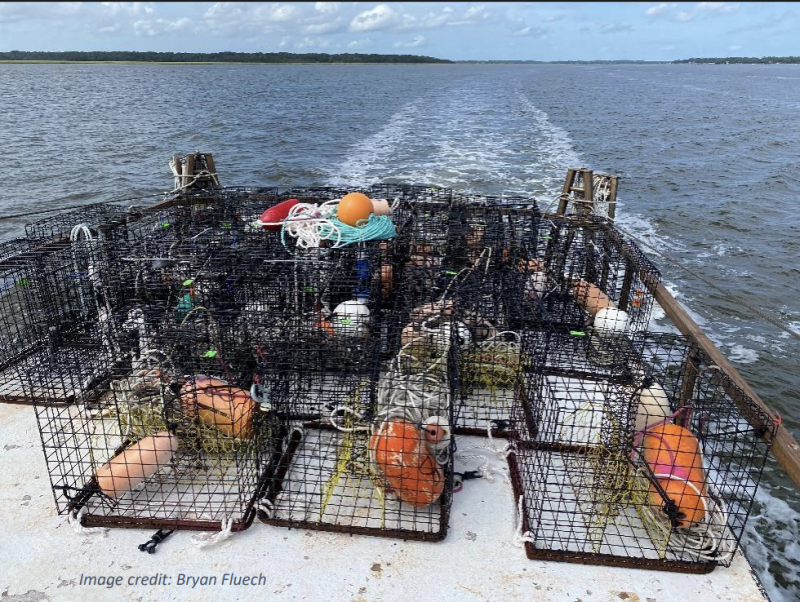Developing on-demand or ‘ropeless’ fish trap gear could allow more fishermen to keep working in the black sea bass fishery from the Carolinas to Florida, even with seasonal closures to protect endangered North Atlantic right whales from gear entanglement.
The South Atlantic Fishery Management Council has begun moving toward making pop-up fish pot gear allowable at all times, after three years of testing under an experimental fishery permit from the council.
In 2017 the fishery was tasked with two seasonal closures from December to March and November to April to protect migrating right whales. Adapting the pot fishery to use on-demand gear – without vertical lines, and buoys that can be summoned by signal from fishermen to pop up for retrieval – underwent testing under the council’s EFP.
That permit expires in April 2025. During a Sept. 14 meeting in Charleston, S.C., the council agreed start a process to make on-demand gear permitted during seasonal closures, said Gib Brogan, a campaign director for the environmental group Oceana that has long advocated for adopting ropeless gear.
“They want to get this done as quickly as possible so there’s no lag between the EFP and having this permitted…2025 is the timeline they’re looking at,” said Brogan, who spoke in favor of the proposal in Charleston.
With a population now estimated at only around 340 animals, North Atlantic right whales are some of the most endangered marine mammals. Female right whales head for the Southeast U.S. waters to deliver their calves, and with intense legal and regulatory pressure to reduce the risk of fishing gear entanglements the South Atlantic council in 2017 introduced
Research into on-demand gear has been ongoing since 2020 under an experimental fishery permit from the council, allowing on-demand gear testing outside the closures by a limited number of fishermen off Georgia and North Carolina.
Successful results led to second EFP from the council to allow on-demand gear testing within the closure areas, with participation from fishermen working with several varieties of the gear in waters from Sneads Ferry, N.C., south to Ormond Beach, Fla. Continuing that research requires new action by the council, according to a summary report from the August workshop.
The council's snapper-grouper committee approved including black sea bass on-demand gear in the black and gag grouper framework amendment, which was then approved by the full council.
There was overall support for moving forward with options for the on-demand gear through the framework amendment process to help expedite any management measures, said Kim Iverson, the council's public information officer.

“On-demand gear has many benefits for the fishermen. It allows fishermen access to areas currently closed in times in which the fish are more readily available closer to shore and market prices are generally higher,” the report notes. “As a result, more economically feasible because more profit and less direct costs (fuel), in addition to safer because fishing closer to shore.
“Making on-demand gear a reality consists of two parts: making on-demand gear an allowable gear under SAFMC regulations, and allowing that gear to be used in the closed areas,” according to the report. “This would not remove the closures, it would just allow fishermen who wish to fish in the closures to do so if they use on-demand gear. Fishermen who wish to use traditional gear would still be able to do so outside of the closures.”
The workshop report includes an estimate that equipping 32 permitted black sea bass boats in the region with the new gear might cost almost $500,000 with the possibility of obtaining finanical aid from the National Oceanic and Atmospheric Administration.
Those whale migration closures affect black sea bass fishing inside of 90-foot depths during the winter months, effectively closing 15,000 square miles of prime fishing ground. Kim Sawicki, founder and president of Sustainable Seas Technology, talked to National Fisherman in 2022 about how testing on-demand gear equipment in Southeast waters can show fishermen and designers how to make the systems work better.
“What we learn from our work here could benefit other pot fisheries facing entanglement issues,” said Sawicki, who also tests ropeless gear with Dungeness crab and spiny lobster fishermen in California, and Maine lobster fishermen in the Northeast. “But every fishery is different, what works for one might not work for another.”
Brogan said it’s evident the concept has broad acceptance among fishermen and the South Atlantic council.
“That’s one of the reasons we’re so enthusiastic about this,” said Brogan. “We’re seeing this, in a lot of ways, as being a model for other regions.”
If Southeast fishermen and fisheries agencies make a success of on-demand gear, their experience can help shape its use in other regions, he said: “Hearing from managers who have done it will make it easier for the next (fishery management) council, and the next one after that.”







